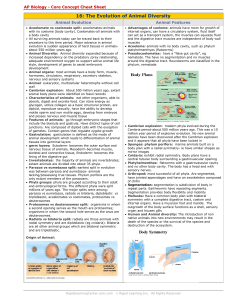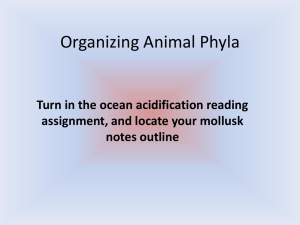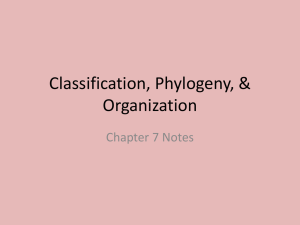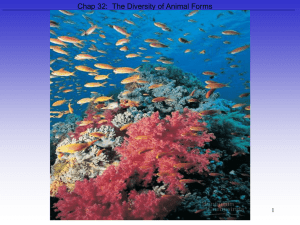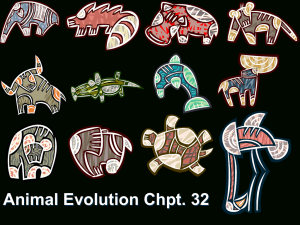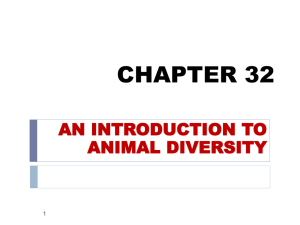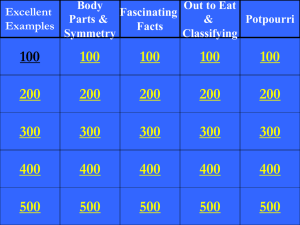body cavity
advertisement
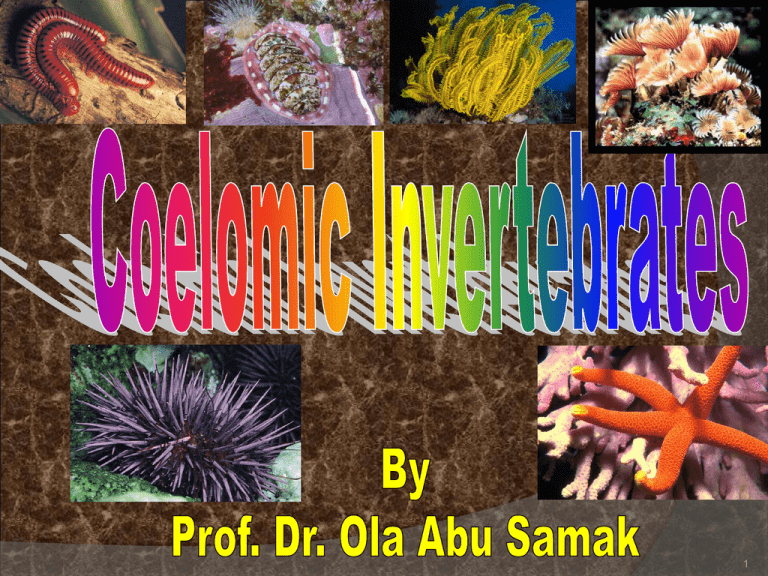
1 Aims of the Course Overall aims: Recognizing the diversity of God’s creation of different coelomic invertebrates animals Developing the familiarity with the coelomic invertebrate phyla Acquisition of facts and concepts on the biology, body organs and their function of invertebrate animal Recognizing of the importance of this course and other scientific courses taught in this program Increasing the teamwork skills and using of internet and microscopes Intended learning Outcomes (ILO’s) Knowledge and Understanding oRecognizing the most major coelomic invertebrate phyla oUnderstanding the biology and internal organs and their function in the different invertebrate animals oUnderstanding the taxonomic classification and evolutionary position of the different phyla Intellectual Skills oComparing between the taxonomic criteria and organs throughout the different invertebrate animals Professional and Practical Skills oExamining the animals using the microscope and drawing their organs to recognize the taxonomic criteria General and transferable Skills oLearning the participating with student colleagues oLoving the scientific courses felt their utility in public life oParticipating in gaining information from the internet 2 Syllabus Introduction• Phylum: Annelida (General charactes)• Nereis• Allolobophra caliginosa• Hirudo medicinalis• Phylum: Arthropoda (General charactes)• Astacus fluviatulis & Neptunus pelagious• Daphnia, Cyclops, Balanus• Scolopendra morsitans, Lycosa ferox• Phylum: Mollusca (General characters)• Acanthochiton spinigira, Helix pomatia• Loligo peadlii, Anodonta sp.• Phylum: Echinodermata (General characters)• Astropecten sp.• 3 Lecture 1 4 Aim What do you know about metazoa ? What do you know about parazoa? What do you know about eumetazoa? What do you know about ceolom(body cavity )? What do you know about Mesenchyme cells ? What do you know about Schizocoelous ? What do you know about Enterocoelous ? What do you know about protostomes ? What do you know about deuterostomes ? What do you know about Invertebrates ? 5 Evolution of life on Earth Plants Fungi Animals Phanerozoic Cambrian 544-535 my Ediacaran 544-600 my 0.5 Multicellular life 1.0 2.0 Eucaryotic cell Proterozoic 3.0 First cells (bacteria) 4.0 Formation of the Earth 6 7 The 32 animal phyla listed in evolutionary relationship Placozoa Acathocephala Echiura Porifera Nematoda Annelida Cnidaria Nematomorpha Phoronida Ctenophora Kinorhyncha Bryozoa (Ectoprocta) Platyhelminthes Loricifera Cycliophora Mesozoa Priapulida Brachiopoda Nemertea Onychophora Echinodermata Gnathostomulida Tardigradia Hemichordata Ectoprocta Arthropoda Chaetognatha Rotifera Mollusca Chordata Gastroctricha Sipuncula ••*Urochordata *Cephalochordata• •*Vertebrata 8 Metazoa The animals have multicellulr body Included Parazoa and Eumetazoa 9 A Parazoa 1- cellular organization: . 2- differentiated cells in layers 3-no true tissues e.g. Porifera (sponges) 10 B Eumetazoa 1- Diploblastic 2- Triploblastic 2 tissue layers 3 tissue layers (ectoderm and endoderm) ectoderm , endoderm & mesoderm No coelom but there is (central important for movement canal) for digestion, circulation 11 12 Body cavities 1 2 3 Is that cavity lying between the body wall and the internal organs. This cavity may be lacking due to the presence of Mesenchyme cells (e.g.platyhelminthes). Bilateral animals having distinct body cavity are either coelomate (the most highly organized animals )or pseudocoelomates (e.g. Nematoda). Mesenchyme cells : are occupying the space between the body wall and the gut of the animals Note 1- the body cavity derived from the blastocoel of the embryo . 2- this cavity is not lined by mesodermal epithelium. 13 Ceolom • 1- Aceolom Internal fluid-filled cavity 2- Pseudoceolom 3- Euceolom 14 Pictures for Illustrations 15 Pictures for Illustrations 16 There are two methods in formation of the ceolom Schizocoelous Enterocoelous Solid masses of mesoderm split to form the coelomic cavities As the archenteron . mesoderm buds off from the wall of the archenteron and hollows to become the coelomic cavities . In a protostome . In deuterostomes . Occurs in Annelida, Arthropoda, Mollusca, … etc Occurs in Echinodermata, Chordata … etc. 17 18 The coelomate phyla are divided into two grades based on differences in their development. 1- protostomes 2-deuterostomes • 1- These differences center on cleavage pattern, coelom formation, and blastopore fate. • 2- Many protostomes undergo spiral cleavage, in which planes of cell division are diagonal to the vertical axis of the embryo. • 3-Some protostomes also show determinate cleavage where the fate of each embryonic cell is determined early in development. 19 The coelomate phyla are divided into two grades based on differences in their development. 4-The zygotes of many deuterostomes undergo radial cleavage in which the cleavage planes are parallel or perpendicular to the vertical egg axis. 5-Most deuterostomes show indeterminate cleavage whereby each cell in the early embryo retains the capacity to develop into a complete embryo. 6- The third difference centers on the fate of the blast pore, the opening of the archenteron. 7- In many protostomes, the blastopore develops into the mouth and a second opening at the opposite end of the gastrula develops into the anus. 8- In deuterostomes, the blastopore usually develops into the anus and the mouth is derived from the secondary opening 20 Functions of Ceolom Internal fluid-filled cavity (body cavity) 1. Its fluid cushions the internal organs, helping to prevent internal injury. 2. The non compressible fluid of the body cavity can function as a hydrostatic skeleton against which muscles can work. 3. The present of the cavity enables the internal organs to grow and move independently of the outer body wall. 21 Invertebrates • • • • • • • • animals that lack vertebrae (classed by a characteristic they don’t have) 97% of all species on Earth are invertebrate Invertebrates include Sponges Cnidarians Molluscs Annelids Nematodes Arthropods Echinoderms (These are all phyla.) 22 Annelida Arthropoda Mollusca Echinodermata 23 Quiz 1- Metazoa Included ………and …….? 2- The animals of Metazoa have …………… body ? 3- Mention three characters of parazoa ? 4- As example of parazoa ……………………..? 5- From your study of zoology what the differentiation of unicellular and multicellular ? 6- Differ between Metazoa and Parazoa ? 7- What the meaning of true tissue ? 8- Eumetazoa include ……… and ………… ? 9- What the meaning of diploblastic a and triploblastic a ? 10- Compare between diploblastic a and triploblastic a ? 11- Mention three characters of body cavity ? 12- What the function of body cavity ? 13- what the meaning of bilateral animals? 24 Quiz Mesenchyme cells are ……… The body cavity divided from ……..and……. Ceolom is ………………… Types of ceolom are ……………and…...........and……… Give meaning to : 1- A ceolom 2- Pseudoceolom 3- Euceolom 4- Schizocoelous 5- Enterocoelous How the ceolom are formatted (two method) ? The coelomate phyla are divided into two grades based on differences in their development ………. And……… What the different between them ? 25 Quiz Invertebrates include ……..,………,………..,………….,……and………. What do you benefit in this lecture ? (write in short point and we will see it in the next lecture ) Prepare the next lecture please 26
